
- Clouds sales and customer services
- Sales Cloud
- Service Cloud
- Marketing clouds
- Marketing Cloud
- Account Engagement (ex Pardot)
- E-commerce clouds and customer experience
- Commerce Cloud
- Experience Cloud
- Analytical and decision-making clouds
- Table
- Einstein Analytics / CRM Analytics
- Sector clouds: solutions by industry
- Financial Services Cloud
- Health Cloud
- Manufacturing Cloud
- Education Cloud
- Conclusion
In an increasingly connected world, cloud computing is becoming a major lever in the digital transformation of businesses. By enabling online access to applications and data in real time, the cloud facilitates collaboration and the synchronization of teamwork. For example, updating a shared document or checking your bank account from a smartphone illustrates just how ubiquitous the cloud has become in our professional and personal activities. According to Gartner, by 2025 over 95% of new digital workloads will be deployed on cloud-native platforms, a sign of the massive adoption of this model.
Salesforce is a pioneer and leader in cloud computing for Customer Relationship Management (CRM). From sales CRM to digital marketing, all its solutions are hosted entirely in the cloud, offering companies flexibility, scalability and access from anywhere. In concrete terms, Salesforce offers a very rich range of “Clouds”, i.e. specialized cloud applications covering all business needs: sales, customer service, marketing, e-commerce, analytics, specific sectors of activity, and so on. These different Salesforce cloud solutions, perfectly integrated with each other, enable organizations to consolidate customer data andoptimize processes in each department, to better serve the end customer.
In this article, we’ll take a look at the main Salesforce clouds, grouped by business purpose. For each solution, we’ll explain its main purpose, who it’s aimed at on the business side, its key features, and give a concrete example of how it’s used. The aim is to provide a clear overview of the Salesforce ecosystem for a beginner to intermediate professional audience, and to demonstrate the value of mastering these tools in a digital and CRM-oriented career.
Clouds sales and customer services
Salesforce’s CRM clouds are designed to improve sales and customer service processes. They form the historical core of Salesforce. The main ones are Sales Cloud and Service Cloud, which target sales and customer support teams respectively.
Sales Cloud

Sales Cloud is Salesforce’s flagship CRM solution for sales automation. Designed for sales teams (field and office-based sales reps, sales managers), it manages the entire sales cycle, from the initial lead to closing the deal. Sales Cloud helps to qualify and track prospects, interact with potential customers and predict sales.
Key features include contact and lead management, pipeline opportunity tracking, sales forecasting, automation of repetitive tasks and mobility (mobile application for mobile sales reps). Integrated analysis tools provide visibility on sales performance to help make informed decisions.
💡 It’s entirely possible touse Salesforce without Sales Cloud. The Salesforce platform is made up of different scalable clouds, and companies can choose only those that match their business needs. For example, an organization focused solely on customer support could use Service Cloud without activating Sales Cloud. The Salesforce environment can be customized according to the specific objectives and processes of each organization.
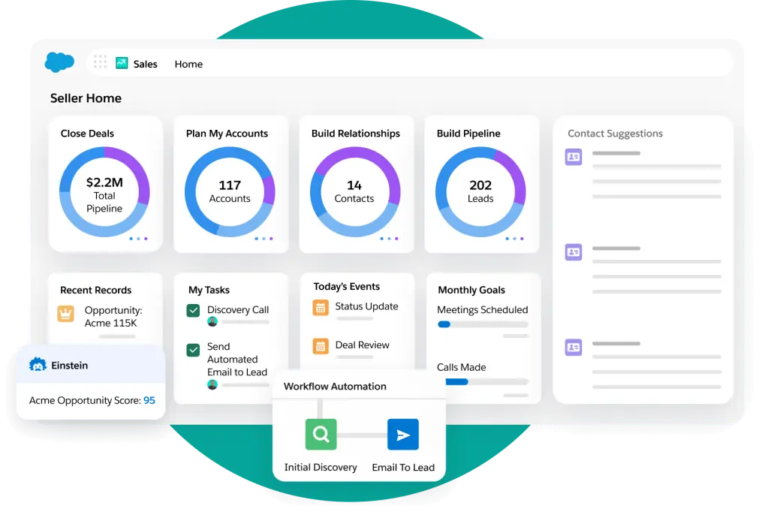
Example of use:
A sales manager in a technology SME uses Sales Cloud to centralize all his contacts and opportunities. When he meets a prospect at a trade show, he creates a lead file in Sales Cloud via the mobile application. The lead is then qualified, transformed into an opportunity and linked to a sales cycle with stages (demonstration, proposal, negotiation). Thanks to automated reminders and visibility of the interaction history, he can follow up at the right moment and maximize his chances of closing the sale. His manager monitors the sales dashboard in real time to adjust sales forecasts.
Salesforce fundamentals
Service Cloud
 Service Cloud is the Salesforce solution dedicated to customer service and after-sales support. Designed for support teams (call centers, helpdesks, after-sales service), it provides a complete set of tools to efficiently manage customer requests across all channels. Service Cloud centralizes the management of tickets (customer cases) from telephone, e-mail, online chat, social networks, etc., to deliver a seamless omnichannel experience. Agents are provided with a unified interface – in other words, a centralized work screen that brings together all the customer’s essential information: purchase history, past requests, recent exchanges with the company, and so on. This enables them to provide a rapid, consistent and personalized response, without having to search for information in several different tools.
Service Cloud is the Salesforce solution dedicated to customer service and after-sales support. Designed for support teams (call centers, helpdesks, after-sales service), it provides a complete set of tools to efficiently manage customer requests across all channels. Service Cloud centralizes the management of tickets (customer cases) from telephone, e-mail, online chat, social networks, etc., to deliver a seamless omnichannel experience. Agents are provided with a unified interface – in other words, a centralized work screen that brings together all the customer’s essential information: purchase history, past requests, recent exchanges with the company, and so on. This enables them to provide a rapid, consistent and personalized response, without having to search for information in several different tools.
Key features include a customer case (or “ticket”) management system, which tracks every customer request from inception to resolution. As soon as a customer reports a problem, the system automatically directs them to the most appropriate agent, based on criteria such as the type of request, the language spoken or the workload of each agent; this is known as intelligent routing. Added to this is a knowledge base for self-service (FAQs, help articles) so that customers can find answers themselves, AI-powered chatbots to automate responses to simple questions, and tools for monitoring SLAs (service level agreements).
Service Cloud also offers specialized modules such as Field Service for managing field interventions (technician scheduling, work orders). Dashboards track indicators such as average resolution time, customer satisfaction and workload per agent.
Example of use:
An e-commerce company uses Service Cloud for its after-sales service. A customer contacts support via the website chat for a faulty product. Service Cloud automatically creates a case and provides the agent with the complete customer file (past orders, warranties, previous incidents). The agent sees that the product is under warranty and, thanks to the knowledge base, sends the exchange procedure directly to the customer. If the customer prefers a phone call, the agent can call him back, and all interactions are logged in the case. The call center supervisor then analyzes Service Cloud reports to identify recurring problems and train his team accordingly, improving satisfaction and loyalty.
Marketing clouds
Salesforce offers clouds specifically designed for marketing teams, to drive campaigns and customer relations upstream of sales. The two main ones are Marketing Cloud and Marketing Cloud Account Engagement (formerly Pardot), covering B2C and B2B marketing needs respectively.
Marketing Cloud
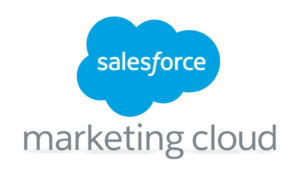
Salesforce’s Marketing Cloud is a completemarketing automation suite for B2C (consumer marketing), although it can also be applied in a B2B context. It is aimed at digital marketing and communications teams who want to engage customers across all channels in a personalized way. Marketing Cloud offers a unified view of the customer, orchestrating consistent campaigns from email to social networks, SMS and online advertising.
Salesforce Marketing Cloud offers tools for managing email campaigns, mobile and social marketing, as well as behavior-based automation of multi-channel customer journeys.
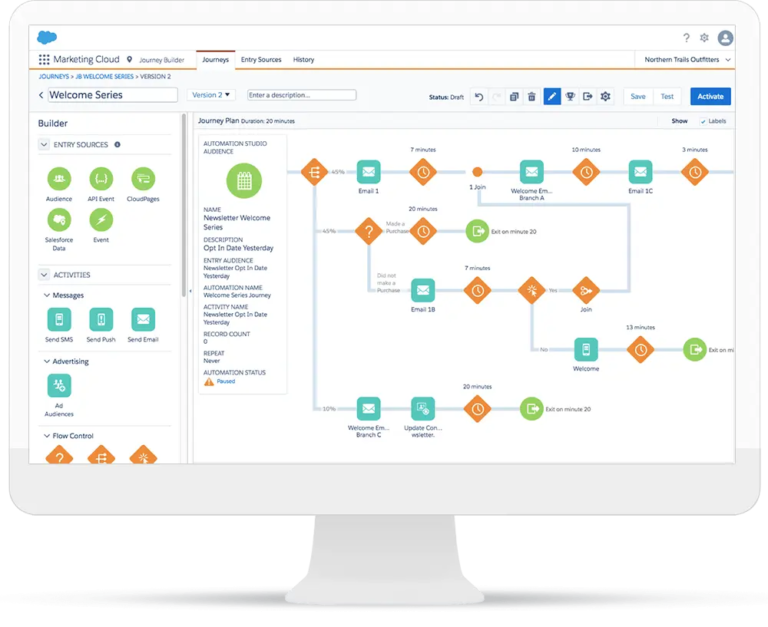
Marketing Cloud also includesmarketing analytics capabilities to measure campaign performance and calculate ROI, as well asartificial intelligence (Einstein) to recommend the best content or timing based on customer data.
In short, this tool helps companies interact with their audience in a more relevant, personalized and timely way, boosting brand awareness and converting prospects into customers.
Example of use:
A hotel chain uses Marketing Cloud to build customer loyalty. When a new customer subscribes to the newsletter, he enters an automated path. First, they receive a personalized welcome email. If this email is not opened, the customer then receives an SMS inviting them to discover the chain’s mobile application.
If they click on a holiday offer in the email, they can then see a targeted advertisement on Facebook for that destination.
At every stage, Marketing Cloud tracks the customer’s actions:
- did he open the email?
- clicked on the offer?
- made a reservation?
If the customer seems interested but doesn’t book right away, the artificial intelligence tool, called Einstein, can suggest sending a promo code to encourage them to finalize their reservation.
Thanks to this suite of connected actions, the hotel chain improves its reservations while offering a fluid, personalized experience across all channels (email, SMS, social networks).
Account Engagement (ex Pardot)
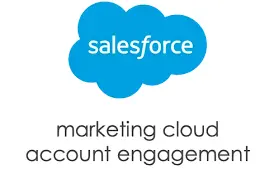
Account Engagement, better known by its former name Pardot, is Salesforce’s marketing automation solution dedicated to B2B. It is aimed in particular at marketing and sales teams working together in a B2B context, where the sales cycle is longer and involves lead nurturing. Pardot enables professional leads to be generated and qualified, nurtured with targeted campaigns, and then passed on to sales staff at the right moment.
Pardot’s key features include management of B2B email campaigns (newsletters, webinars, white paper content…), lead scoring and grading (scoring leads based on their interactions and profile to identify those most likely to buy), creation of landing pages and forms to capture new prospects, andnative integration with Sales Cloud so sales teams have visibility of marketing leads. Pardot also provides detailed reports on campaign effectiveness (conversion rate, lead source, ROI) to adjust marketing efforts. By automating these tasks, the tool helps to align marketing and sales around the same revenue objectives.
Example of use:
A B2B software solutions provider uses Pardot to supply its sales team with quality leads.
Marketers organize a webinar on a business theme and use Pardot to manage email invitations and registrations via a dedicated landing page. Following the webinar, Pardot automatically sends participants a thank-you email with a free trial offer. It then monitors who clicks and registers for the trial. Leads who achieve a sufficient score (for example, who have opened several emails and visited the product site) are automatically assigned to a sales rep in Sales Cloud, with full details of their interactions. The sales rep can then contact this “hot” prospect with knowledge of their areas of interest, increasing the chances of closing a sale.
This process automates lead qualification and ensures that the sales team focuses on the best opportunities.
E-commerce clouds and customer experience
Salesforce also offers cloud solutions for managing online sales and creating engaging digital experiences for customers or partners. The two main ones are Commerce Cloud for e-commerce and Experience Cloud for customer experience/online community sites.
Commerce Cloud
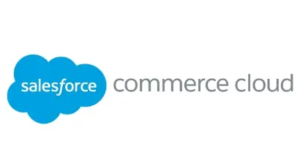
Commerce cloud is the Salesforce platform dedicated to unified e-commerce. It is aimed at e-commerce managers, digital teams and CIOs looking to deploy high-performance e-commerce sites, whether in B2C (sales to consumers) or B2B (sales to businesses). Commerce Cloud provides a robust foundation for creating customizable online stores and managing the entire order cycle, from product navigation to shopping cart and payment.
Among the features provided are the creation of customizable online storefronts (choice of templates, responsive design for mobile), real-time product catalog and inventory management, a centralized order management module to track purchases across all channels, and support for multiple payment methods and currencies. Commerce Cloud also integrates artificial intelligence tools to enhance the shopping experience, such as personalized product recommendations (“you might like…”) or site-internal search optimization. Promotional features (discount codes, bundled offers) and quick checkout are included to maximize conversion rates.
On the back-office side, the platform offers online sales dashboards, and can connect to Salesforce CRM to unify e-commerce data with customer data (service, marketing, etc.).
Example of use:
A sporting goods manufacturer uses Commerce Cloud for its international online sales site. The solution enables it to create an attractive e-commerce site, where customers can browse by sport category, see real-time stock for each product and benefit from personalized recommendations based on their previous purchases.
For example, when a customer adds a pair of running shoes to their shopping cart, the site automatically suggests matching sports socks, thanks to the artificial intelligence built into Commerce Cloud. The customer can then choose from several payment methods, such as Apple Pay, credit card or PayPal, and then opt for home or in-store delivery.
All these interactions (products viewed, purchased, cart abandonments) are recorded in Salesforce, enabling the marketing team to follow up customers who have not finalized their order, or to analyze purchasing trends by customer segment.
The result: a smooth, consistent shopping experience across all devices, and increased sales thanks to personalization.
Experience Cloud

Experience Cloud (formerly known as Community Cloud) is Salesforce’s solution for creating interactive web experiences: online communities, customer portals, partner extranets or employee intranets.
It enables companies to rapidly set up CRM-connected websites to engage their customers, partners or collaborators in a dedicated space. This cloud is aimed at customer experience managers, community managers, partner managers or any company wishing to offer a self-service portal.
With Experience Cloud, you can build customized portals without advanced coding, thanks to predefined templates and drag-and-drop components.
These portals can serve different purposes: for example, a customer community for users of your products to help each other (forum, FAQ), or a partner space for exchanging leads and tracking co-selling opportunities. Features include knowledge sharing (publication of articles, FAQs), the ability for customers to submit and track self-service support cases, event or idea management, and moderation and analytics tools to track community engagement.
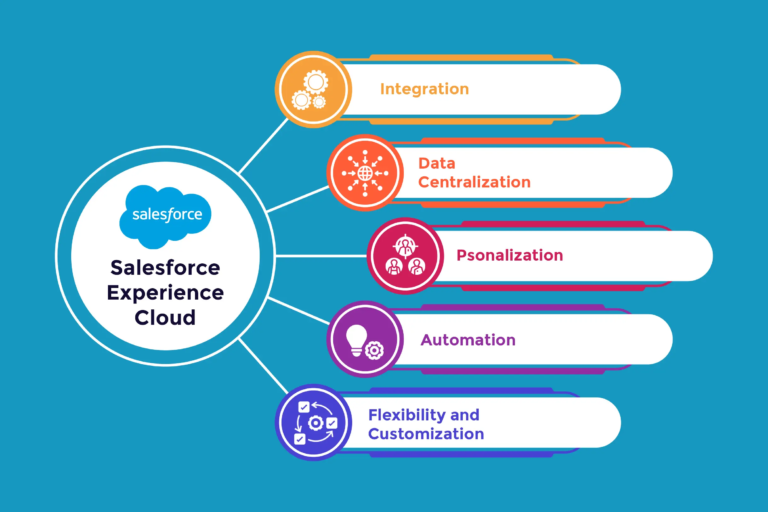
As Experience Cloud is natively connected to Salesforce CRM, all data (user profiles, portal activities) is consolidated in a single customer database. This enables an internal account manager, for example, to see the posts a customer has published on the community, or the tickets he or she has created.
Example of use:
An electronics manufacturer sets up an online community via Experience Cloud to offer support and advice to its customers.
On this portal, customers can create an account (linked to their Salesforce profile) and access technical documentation, ask questions that are answered by other customers or moderators, and check the progress of their support requests. A customer encounters a problem with his connected camera: he goes to the community, looks for the solution in the available articles and, not finding it, posts his question. A community member replies with the solution within a few hours, avoiding a call to support. The customer evaluates the answer positively.
For his part, the support manager analyzed that 30% of the questions asked this month concerned the camera in question: he decided to create a tutorial article in the knowledge base for future users. Thanks to Experience Cloud, the company has reduced the volume of incoming calls and increased satisfaction by offering a self-service support area.
Analytical and decision-making clouds
Beyond transactional applications (sales, marketing, etc.), Salesforce offers solutions fordata analysis and decision support. These analytical tools harness the wealth of customer data into actionable insights. The most important are Tableau and Einstein Analytics/CRM Analytics.
Table
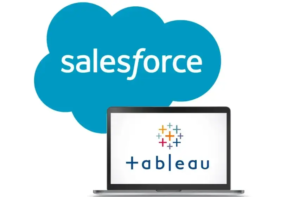
Tableau is the leading Business Intelligence (BI) platform acquired by Salesforce in 2019. It is a powerful data visualization and analysis tool that is not limited to Salesforce CRM data, but can connect to a multitude of data sources (files, databases, Big Data, etc.). Tableau is aimed at business analysts, data scientists and managers who want to explore their data freely and create visual dashboards to inform decisions.
Considered one of the leading analytics platforms on the market, Tableau enables everyone to make decisions faster and on the basis of reliable data.
Features include a drag-and-drop interface for creating interactive visualizations (charts, maps, diagrams) without programming, the ability to merge data from a variety of sources, add custom calculations and indicators, and share dynamic dashboards via the web or mobile application. Tableau excels in the visual representation of complex data to make it comprehensible to decision-makers. It also offers advanced analytics capabilities by integrating statistics and AI (e.g., explaining variations in an indicator, detecting anomalies).
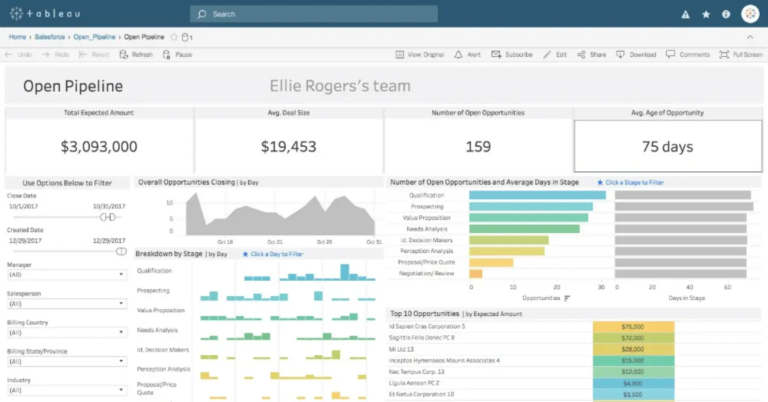
Example of use:
An international company collects sales data in Salesforce, financial data in ERP, and Google Analytics web data.
A business analyst uses Tableau to combine these sources and create an executive dashboard. This presents, by region, actual vs. forecast sales, customer acquisition cost, and customer satisfaction (from surveys). He has built interactive filters by product and by quarter. Management consults this dashboard via a secure link and can, in a few clicks, explore the performance of each market and product segment.
Thanks to Tableau, the company has established a data-driven culture, where decisions (budget allocation, strategic orientations) are made on the basis of shared, clearly visualized indicators.
Einstein Analytics / CRM Analytics
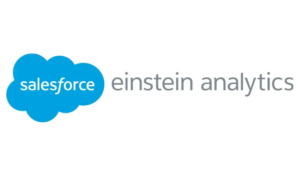
Einstein Analytics, later renamed Tableau CRM and now known as CRM Analytics, isSalesforce’s native data analysis solution. Unlike Tableau, which is an independent platform that can be used for all kinds of data, CRM Analytics is directly integrated with Salesforce and aims to bring actionable insights into the CRM workflow. It is aimed at users and managers in sales, marketing and service who want to benefit from advanced analysis without leaving the Salesforce environment.
CRM Analytics offers interactive dashboards combining classic analyses (graphs, filters, data exploration) and advanced functionalities powered byAI (Einstein) directly within Salesforce. These analyses are directly accessible within Salesforce, enabling users to visualize their key indicators without leaving their work environment.
For example, a sales manager can consult a Sales Cloud home page enriched with predictive indicators on his pipeline (score of opportunities to prioritize, AI sales forecast for the quarter) without having to go to another tool. The platform lets you create customized dashboards combining CRM data and external data if required, with filters, drill-downs (detailed exploration) and even automatic explanations of trends thanks to Einstein. It offers intelligent predictions and recommendations, for example to identify customers at risk of churn or the product most likely to interest a given customer.
The beauty of CRM Analytics is that it brings these insights directly to the right people, at the right time, in their working context (hence the term contextual insights).
Example of use:
A customer support manager uses CRM Analytics to improve service quality. In his Service Cloud dashboard, he has a CRM Analytics widget that analyzes all support cases over the last 6 months. The Einstein tool has detected that tickets related to product “X” take on average 30% longer to resolve than others, and predicts a risk of lower satisfaction in this segment. CRM Analytics recommended that he investigate this finding further. He clicks to see the detailed analysis: it appears that the problem stems from a lack of documentation for product X and an initial misclassification of cases. Following this insight, the manager launches an action: organize specific training for agents on this product and enrich the knowledge base.
Here, CRM Analytics was used to uncover a hidden insight and immediately transform it into an action plan for the manager, all without leaving Salesforce.
Analyze your data with CRMA
Sector clouds: solutions by industry
Salesforce has developed sector-specific cloud offerings to meet the specific business needs of these industries. These vertical solutions, often based on the expertise of Salesforce Industries (ex-Vlocity), provide pre-configured business objects, processes and data models to accelerate CRM deployment in the sector concerned.
Here are the main industry clouds:
Financial Services Cloud
A CRM solution designed for the financial sector, including banking, insurance and asset management, it helps financial advisors and account managers to manage long-term relationships with their customers.
The tool brings together all the customer’s financial information (bank accounts, investments, insurance) in a single view to provide personalized advice.
For example, a wealth management advisor can see all the customer’s assets in a single customer file, and can plan proactive interactions (investment advice, reminders about suitable products). Financial Services Cloud includes industry-specific functionalities such as family and household management (grouping several people from the same family into a financial household), referral and recommendation tracking, and regulatory compliance (interaction history, consent management).
Example of use:
In a private bank, an advisor uses Financial Services Cloud to segment his customer portfolio by asset value and receive alerts when one of them makes an important change (e.g. massive withdrawal, maturity of a savings product), so that he can proactively contact them with appropriate advice.
Health Cloud
Vertical cloud for the healthcare sector: hospitals, clinics, health insurance. It enables you to manage patients as if they were customers, offering a 360° view of the care pathway. Health Cloud consolidates relevant medical data (treatment history, appointments, medication, test results) and facilitates coordination between healthcare professionals. A common use case is homecare management: a hospital can track its post-operative patient list in Health Cloud, with their assigned nurses, next scheduled visits and alerts if particular follow-up is required. The platform thus enhances personalized care by centralizing patient information and triggering automatic follow-up tasks.
Example of use :
In one clinic, the manager uses Health Cloud to visualize a patient’s progress (admissions, medical procedures, follow-up consultations) on a single timeline. He notices that, for a diabetic patient, no follow-up appointments are scheduled after discharge – he then programs an automatic reminder to this patient to schedule a follow-up consultation, improving continuity of care.
Manufacturing Cloud
Dedicated to the manufacturing and industrial sector, it aims to bring sales teams and operations closer together. Manufacturing Cloud provides end-to-end visibility of sales, order and production forecasts, to optimize supply and demand. For example, it can manage commercial agreements (recurring sales contracts with forecast volumes) and compare actual orders with forecasts in real time, in order to adjust production. Industrial account managers can track customer commitments (e.g. a customer has promised to buy 1,000 parts over the year), and the supply chain team can see whether the order rate is on target.
Example of use:
A manufacturer of electronic components uses Manufacturing Cloud to collaborate with its main automotive customer. Together, they draw up an annual account plan forecasting monthly quantities. Manufacturing Cloud keeps track of progress: if orders drop off in a given month, an alert is sent to sales to renegotiate or inform production to adjust raw material stocks. This avoids overstocking or stock-outs by making the sales-production process more transparent.
Education Cloud
Designed for educational establishments (universities, schools), it serves as a central system for managing the student lifecycle, from recruitment to alumni. Education Cloud offers specific objects for applications, curricula and academic results, and facilitates personalized communication with students and alumni.
Example of use :
A university deploys Education Cloud to keep track of its applicants and students: the admissions team manages all applications in the CRM, sends targeted emails to admitted applicants to encourage them to enroll, and then once the student is on board, his or her file is tracked (course registration, grades, diplomas obtained). After graduation, they are transferred to the alumni module, which keeps them in touch via newsletters and solicitations (donations, participation in events). In this way, the university benefits from a single view of the student’s journey from prospect to graduate, improving alumni recruitment and retention.
In addition to these examples, Salesforce offers other industry-specific clouds (in some cases resulting from the acquisition of Vlocity) such as Communications Cloud (for telecom operators), Media Cloud (media and advertising), Energy & Utilities Cloud (energy sector) or Public Sector Solutions (public sector). Each aims to accelerate the implementation of a CRM adapted to specific industry processes, avoiding the need to start from scratch in terms of configuration.
Conclusion
As we’ve just seen, Salesforce has a very broad portfolio of clouds covering most of the digital needs of the modern enterprise. From basic CRM to sector-specific solutions, omnichannel marketing, e-commerce, analytics and integration, these clouds form a coherent ecosystem that helps organizations work more effectively and collaboratively around customer data. For a professional looking for a career in digital, CRM or digital transformation, it’s invaluable to be familiar with these different solutions. In fact, understanding the main Salesforce clouds will give you a better grasp of how companies are improving their business processes thanks to the cloud, and thus position you as an interlocutor capable of proposing solutions tailored to your needs (sales, marketing, service, etc.).
What’s more, as Salesforce is the CRM market leader, mastery of its ecosystem is highly sought-after. Most positions involving customer relationship management, data analysis or digital project management require knowledge of these tools. Salesforce certifications are specific to each of these clouds or fields (Administrator, Consultant, Developer, Architect, etc.). Obtaining these certifications means proving your competence in a given solution (e.g. Marketing Cloud Email Specialist, Sales Cloud Consultant, Tableau Analyst), and therefore increasing your attractiveness on the job market.
In short, an introduction to the main Salesforce clouds means not only understanding the levers of digital transformation in the enterprise, but also giving yourself the means to develop your career in the world of CRM and tech with up-to-date, sought-after skills.






